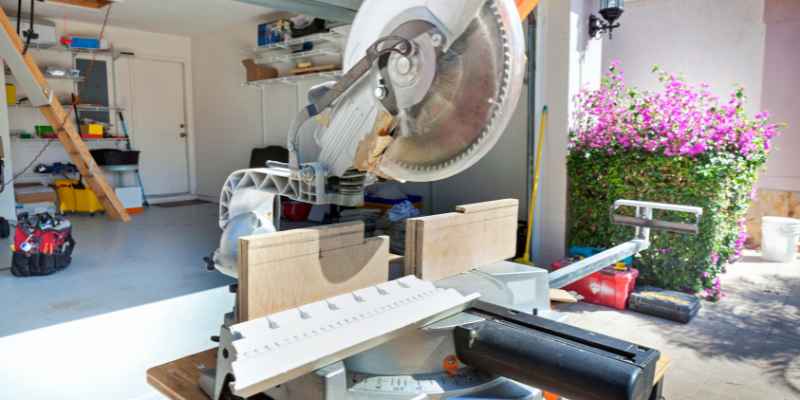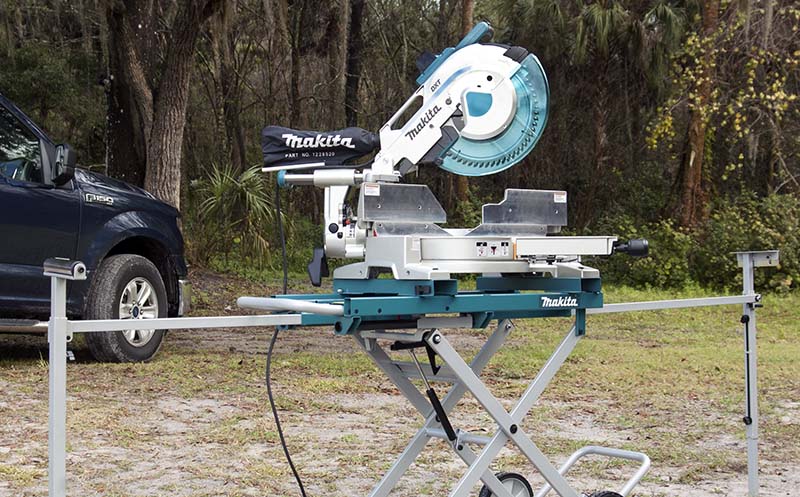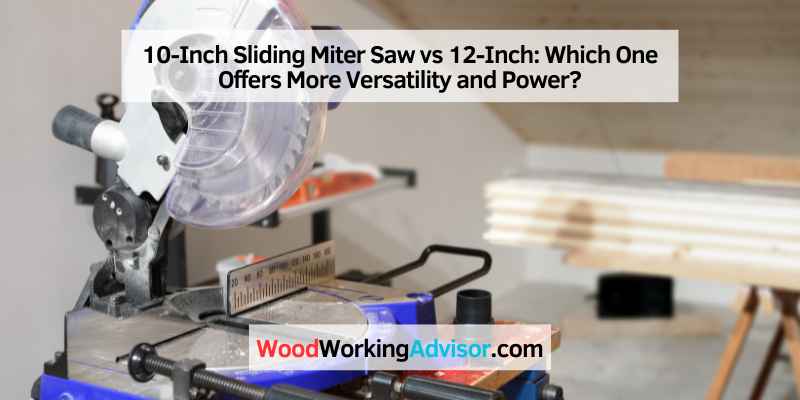A few key differences exist between a 10-inch sliding miter saw and a 12-inch sliding miter saw. The size of the blade is the most apparent Difference, but there are also different motor sizes, weight capacities, and cutting capacities. Here’s a closer look at each area to help you decide which size saw suits your needs.
There are a lot of different opinions out there about which size sliding miter saw is best for the average woodworker. Some say the 10-inch model is just fine, while others claim the 12-inch version is a must-have. So, which one should you buy?
The answer depends on what you plan to use your saw for. If you only need to make occasional cuts and don’t have a lot of space in your workshop, then the 10-inch model might be a good choice. On the other hand, if you do a lot of woodworking or have a more extensive workshop, the 12-inch model would be better suited for your needs.
No matter your size, ensure a good quality saw that will last for years.

10 Inch Vs. 12 Inch Miter Saw Reddit
When choosing a miter or saw, the blade size is one of the most important considerations. So, what’s the Difference between a 10-inch vs. 12-inch miter saw? The most significant difference between these two blade sizes is the depth of cut they can provide.
A 10-inch blade can make a maximum cut of 2-3/8 inches, while a 12-inch knife can make up to 4 inches. If you need to make deeper cuts, you’ll need to opt for the 12-inch saw. Another thing to consider is the price.
Generally speaking, 12-inch miter saws are more expensive than their 10-inch counterparts. This is because they offer more power and capacity. A 10-inch saw may be a better option if you have a limited budget.
Finally, think about the types of materials that you’ll be cutting most often. If you primarily work with softwoods like pine or cedar, then a 10-inch saw should suffice. However, if you frequently cut more complicated wood or composite materials, then a 12-inch saw will give you the best results.
10-Inch Sliding Compound Miter Saw Cut Capacity
A 10-inch sliding compound miter saw is hard to beat when making precision cuts. This type of saw is typically used by woodworkers and contractors who need to create clean, precise cuts in lumber or other materials. The fact that the blade on a 10-inch sliding compound miter saw can slide back and forth makes it possible to cut boards up to 12 inches wide.
And because the blade can be tilted at different angles, this saw can also be used for making beveled cuts.
Best 10-Inch Sliding Miter Saw
Many people don’t know a 10-Inch Sliding Miter Saw, but it’s a convenient tool. It’s great for making precise cuts in wood and can even be used to cut metal if you have the right blade. There are many different brands and models of 10-Inch Sliding Miter Saws on the market, so it can be tough to decide which one is right for you.
We’ve put together this list of the best 10-Inch Sliding Miter Saws. We’ve included both corded and cordless models on our list, so you can choose the one that best suits your needs. We’ve also included a variety of price points, so you can find a saw that fits your budget.
No matter your needs, we’re confident you’ll find the perfect 10-Inch Sliding Miter Saw on our list.
10″ Or 12 Inch Miter Saw Forum
When choosing a miter or saw, one of the most important decisions you’ll make is deciding between a 10″ or 12″ model. Both sizes have pros and cons, so it’s essential to understand the difference before making your purchase. A 10″ miter saw is smaller and more compact than a 12″, making it easier to transport and maneuver.
It’s also less expensive than a 12″. However, a 10″ saw can’t cut as wide of boards as a 12″, so keep that in mind if you’re looking to do some significant projects. A 12″ miter saw is going to be bulkier and more expensive. Still, it can handle wider boards and tougher cuts.
If you’re planning on doing some severe woodworking, then a 12″ miter saw is probably the way to go. Ultimately, the decision between a 10″ or 12″ miter saw comes down to personal preference and what you’ll be using the saw for. If you’re doing some basic DIY projects around the house, then a 10″ saw should suffice.
But if you’re looking to do some heavy-duty work, you’ll need to invest in a 12″.
Best 10-Inch Miter Saw
A 10-inch miter saw is an excellent tool for any woodworker. It can make precise cuts in both small and large pieces of wood. There are many different types of miter saws on the market, so it is essential to research them before purchasing one.
Here are some things to keep in mind when looking for a 10-inch miter saw:
1. Blade size – The blade size is essential when choosing a miter saw. A larger blade can make more aggressive cuts, but it will also be more challenging to control.
If you are new to using a miter or aw, it might be best to start with a smaller blade size.
2. Blade type – There are two main blades for miter saws: carbide and steel. Carbide blades stay sharper for longer and can handle more wear and tear than steel blades.
However, they are also more expensive. Steel blades are less costly but need to be replaced more often.
3. Miter angle range – This is the measurement of the angle at which the blade can cut through wood. The more extensive the range, the more versatile the saw will be. Most 10-inch miter saws have a range between 0 and 45 degrees.
4. Bevel capacity – This refers to the maximum angle the blade can tilt while maintaining contact with the workpiece. Most 10-inch m miter saws have a bevel capacity between 0 and 45 degrees.
Bosch 10 Vs 12 Miter Saw
When it comes to miter saws, there are a few different options on the market. But two of the most popular models are the Bosch 10-inch and 12-inch miter saws. So, which one is the better option for you?
The Bosch 10-inch miter saw is an excellent choice for those who need a compact and lightweight tool. It’s easy to transport and can be used in tight spaces. Plus, it has a powerful motor that can handle even tough cuts.
On the other hand, the Bosch 12-inch miter saw is a good option for those who need more cutting power. It’s slightly heavier than the 10-inch model but has a larger blade that can make more significant cuts. Plus, it has an extended fence that makes cutting long pieces of wood easier.
So, which Bosch miter saw is right for you? If you need a compact, lightweight tool, go with the 10-inch model. But if you need more cutting power, choose the 12-inch model.
12-Inch Miter Saw Cut Capacity
When it comes to a 12-Inch Miter Saw, the cut capacity is one of the most important specs to consider. This is because the cut capacity will determine how big of a piece of material you can cut with your saw. And, if you’re looking to make precision cuts, you’ll want to ensure that your miter saw has a significant enough cut capacity to handle the materials you’ll be working with.
So, what is the cut capacity on a 12-Inch Miter Saw? Well, it depends on the model of the saw that you have. Some models may have a smaller cutting capacity than others.
However, as a general rule of thumb, most 12-inch miter saws will have a cutting capacity of around 6 or 8 inches. This means that you’ll be able to easily cut through pieces of wood that are up to 6 or 8 inches thick. Of course, if you need to make broader cuts, you may need to look for a different model saw altogether.
But, for most people, a 12-inch miter saw with a six or 8-inch cutting capacity should suffice.
10-Inch Miter Saw Cut Depth
When it comes to precise cuts, a 10-inch miter saw is a handy tool in your arsenal. But what exactly is the cut depth on a 10-inch miter saw? The cut depth of a 10-inch miter saw refers to the maximum thickness of material the blade can cut through in a single pass.
The maximum cutting depth for most 10-inch miter saws is around 2-3 inches. However, some models have a higher cutting capacity, so it’s always best to check the specifications of your particular saw before making any assumptions. If you need to make deeper cuts, you can always make multiple passes with the blade or use a different type of saw altogether.
But for most general woodworking and home improvement projects, a 10-inch miter saw with a 2-3 inch cutting depth will suffice.

Credit: www.protoolreviews.com
Is a 10-Inch Miter Saw More Accurate Than a 12-Inch?
The size of a miter saw does not determine the tool’s accuracy. The blade’s quality, the fence’s alignment, and the platform’s stability are much more critical factors in achieving accurate cuts. That said, a smaller miter saw is often more maneuverable and easier to control, which can lead to greater precision.
What is the Difference between a 10-Inch And a 12-Inch Miter Saw?
When it comes to miter saws, one of the main differences you’ll find between a 10-inch and 12-inch model is the blade size. As you might expect, a 10-inch miter saw is equipped with a 10-inch blade, while a 12-inch model has a larger 12-inch blade. This difference in blade size can have an impact on a few different aspects of using the saw.
For one thing, the larger blade on a 12-inch miter saw can make cutting through more rigid materials like hardwoods easier. It can also give you the ability to make broader cuts than what’s possible with a 10-inch model. Another difference between these two types of miter saws is power.
In general, 12-inch models tend to have more powerful motors than their 10-inch counterparts. This means that they can handle heavier workloads and make faster cuts. Finally, there are also some notable differences in price between these two types of miter saws.
In general, 10-inch models will be more affordable than 12-inch models. However, some high-end 10-inch models can cost as much as some lower-end 12-inch models. So, which type of miter saw is right for you?
If you need to make large or wide cuts or plan on cutting more challenging materials regularly, then opting for a 12-inch model makes sense. These saws are also a good choice if you need extra power for making quick work of your cutting projects.
Can a 10-Inch Sliding Miter Saw Cut 2X12?
If you’re looking for a powerful sliding miter saw that can handle significant cuts, the 10-inch sliding miter saw is a great option. This type of saw can easily cut through 2×12 lumber, making it an excellent choice for projects that require large pieces of wood.
What Size Board Will a 10-Inch Sliding Miter Saw Cut?
A 10-inch sliding miter saw will cut boards up to 12 inches wide. It can also make angled, or miter cuts on panels up to 10 inches wide.
Conclusion
In terms of a miter saw, the size of the blade will be one of the main differences you’ll notice between a 10-inch and 12-inch. As the name suggests, a 10-inch sliding miter saw has a 10-inch blade while a 12-inch sliding miter saw has… you guessed it, a 12-inch knife. So what does this mean for you?
Well, with a larger blade comes a few different benefits. For starters, you can make broader cuts with a 12-inch knife. This can come in handy if you’re working on larger pieces of trim or molding.
Additionally, the larger blade will also allow you to make deeper cuts as well. So if you need to cut through something thick like baseboards or crown molding, then a 12-inch sliding miter saw will be your best bet.



4 thoughts on “10-Inch Sliding Miter Saw vs 12-Inch: Which One Offers More Versatility and Power?”